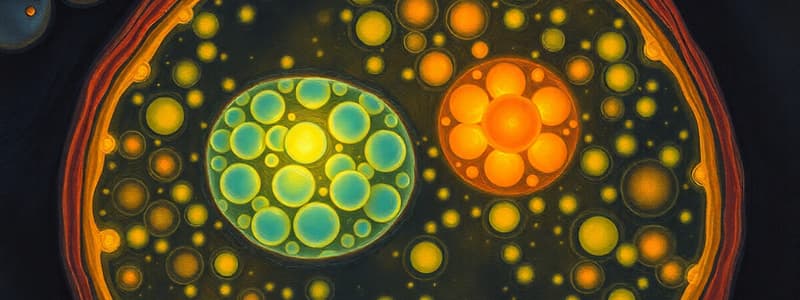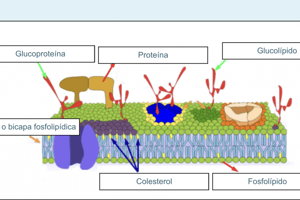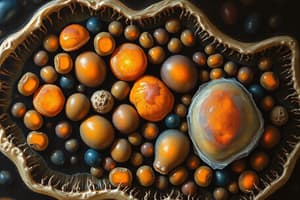Podcast
Questions and Answers
What is the primary function of mitochondria in cells?
What is the primary function of mitochondria in cells?
- Protein synthesis
- Nutrient absorption
- Cell division
- Energy production (correct)
Which statement about mitochondria is accurate?
Which statement about mitochondria is accurate?
- They are responsible for photosynthesis.
- They contain their own DNA. (correct)
- They are involved in water regulation.
- They help in detoxifying the cell.
Mitochondria are involved in a process called oxidative phosphorylation. What is this process primarily associated with?
Mitochondria are involved in a process called oxidative phosphorylation. What is this process primarily associated with?
- Cell signaling
- DNA replication
- Generating ATP (correct)
- Synthesis of lipids
Which of the following best describes the structure of mitochondria?
Which of the following best describes the structure of mitochondria?
Mitochondrial dysfunction can lead to which of the following conditions?
Mitochondrial dysfunction can lead to which of the following conditions?
Flashcards
What is a mitochondrion?
What is a mitochondrion?
A mitochondrion is a small organelle found in most eukaryotic cells. It's the powerhouse of the cell, producing energy in the form of ATP.
Study Notes
Mitochondria: Structure and Function
- Mitochondria are membrane-bound organelles found in most eukaryotic cells.
- They are often described as the "powerhouses" of the cell because they generate most of the cell's supply of adenosine triphosphate (ATP), which is used as a source of chemical energy.
- Mitochondria are typically oval or bean-shaped, though their shapes can vary depending on the cell type and their activity levels.
- Their size typically ranges from 0.5 to 1.0 micrometers in length.
Mitochondrial Structure
- Mitochondria have a double membrane structure, consisting of an outer membrane and an inner membrane.
- The outer membrane is smooth and permeable to various molecules.
- The inner membrane is highly folded, forming cristae, which significantly increase its surface area. This increased surface area is crucial for ATP production.
- The space between the inner and outer membrane is called the intermembrane space.
- The inner membrane encloses a matrix, a gel-like substance containing enzymes, mitochondrial DNA (mtDNA), and ribosomes.
Mitochondrial Functions
- ATP Production (Cellular Respiration): Mitochondria are the primary sites for cellular respiration, a process that breaks down glucose and other molecules to produce ATP.
- Heat Production: Non-shivering thermogenesis utilizes mitochondria to generate heat. This is crucial for maintaining body temperature, especially in newborn mammals and some other animals.
- Calcium Homeostasis: Mitochondria play a vital role in regulating calcium levels within the cell. They act as calcium stores, buffering intracellular calcium concentrations.
- Apoptosis: Mitochondria are involved in programmed cell death, a process called apoptosis. Release of certain molecules from the mitochondria triggers the cascade of events leading to cell death.
- Metabolic Regulation: Mitochondria participate in various metabolic pathways beyond cellular respiration. This includes producing certain amino acids and heme groups (part of hemoglobin).
- Steroid Hormone Synthesis: Mitochondria are involved in the process of producing some steroid hormones in specific cells.
- Bioluminescene: In some organisms, such as fireflies, mitochondria are part of the bioluminescence process.
Mitochondrial DNA (mtDNA)
- mtDNA is a small, circular DNA molecule found within the mitochondrial matrix.
- It contains genes that code for some mitochondrial proteins.
- mtDNA is maternally inherited.
- mtDNA mutations can be linked to various diseases affecting energy production.
Importance of Mitochondria
- Mitochondria are essential for the survival of eukaryotic cells. Their function affects various aspects of cellular activity, from energy production to cell signaling.
- Their ability to continuously produce ATP is crucial for maintaining cellular processes, from intracellular transport to muscle contraction.
- Damage to mitochondria or alterations in their function are associated with several diseases, including mitochondrial diseases and aging-related conditions.
Studying That Suits You
Use AI to generate personalized quizzes and flashcards to suit your learning preferences.




